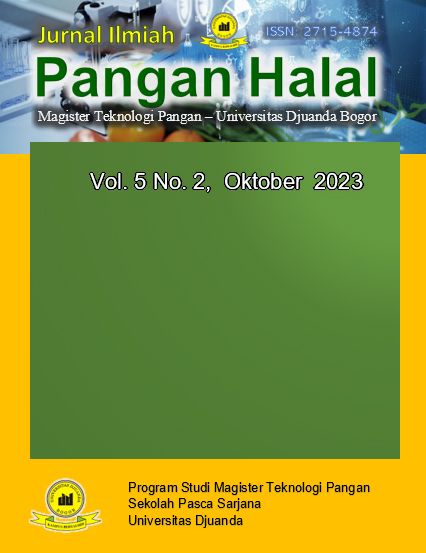Penerapan Teknologi Nanokomposit Pada Kemasan Pangan
Main Article Content
Abstract
Nanotechnology is the manipulation and use of materials and structures on the nanometer scale, roughly between 1 and 100 nm. Nanotechnology has invaded the agri-food industry, with many applications. Nanocomposite is one of the development technologies of Nanotechnology. Nanocomposite packaging is a polymer in which certain types of nano materials have been inserted, such as nano composite clay, nano silica particles (SiO2), carbon nanotubes, graphene, starch nanocrystals, cellulose-based nanofiber or nanowhiskers, chitin chitosan nanoparticles and other inorganics. This paper reviews the main applications of nanocomposites in the field of food packaging. The writing method used in writing this article review is a comparative writing method by collecting various sources obtained from several research journals from 2014 - 2021. From the results of this study, it was found that nanocomposites have very broad potential for their use as food packaging. Such as increasing antimicrobial ability, extending shelf life, maintaining color and sensory quality, as well as other benefits. However, it is necessary to carry out further identification regarding the nature of the interactions between nanoparticles and their effects on the food packaging application process.
Article Details

This work is licensed under a Creative Commons Attribution-NonCommercial-ShareAlike 4.0 International License.
References
Adnan, Dr. H. I. M., & Hamim, Prof. Dr. S. H. (2014). Filsafat Ilmu, Ilmu Pengetahuan dan Penelitian (M. N. Rohman, Ed.; Revisi). Trussmedia Grafika.
Agriopoulou, S. (2016). Nanotechnology in Food Packaging. EC Nutrition, 5, 1137–1141.
Amin, H. H. (2021). Safe ulvan silver nanoparticles composite films for active food packaging. American Journal of Biochemistry and Biotechnology, 17(1), 28–39.
Azizi, S., Ahmad, M. B., Ibrahim, N. A., Hussein, M. Z., & Namvar, F. (2014). Cellulose nanocrystals/ZnO as a bifunctional reinforcing nanocomposite for poly(vinyl alcohol)/chitosan blend films: Fabrication, characterization and properties. International Journal of Molecular Sciences, 15(6), 11040–11053.
Berekaa, M. M. (2015). Nanotechnology in Food Industry; Advances in Food processing, Packaging and Food Safety. Int.J.Curr.Microbiol.App.Sci, 4(5), 345–357.
Fatmawati, D. (2022, May 7). Aplikasi Nanoteknologi dalam Kemasan Pangan. Media Mahasiswa Indonesia. https://mahasiswaindonesia.id/aplikasi-nanoteknologi-dalam-kemasan-pangan/
Iko Anggara Putra, & Jumiono, A. . (2021). Proses Pengolahan Susu Ultra High Temperature (Uht) Beserta Kemasan Yang Berpengaruh Terhadap Masa Simpan. Jurnal Ilmiah Pangan Halal, 3(1), 44–48. https://doi.org/ 10.30997/jiph.v3i1.8729
Kuswandi, B. (2017). Nanotechnology in Food Packaging. 151–183.
Lin, L., Gu, Y., & Cui, H. (2019). Moringa oil/chitosan nanoparticles embedded gelatin nanofibers for food packaging against Listeria monocytogenes and Staphylococcus aureus on cheese. Food Packaging and Shelf Life, 19, 86–93.
Medina, E., Caro, N., Abugoch, L., Gamboa, A., Díaz-Dosque, M., & Tapia, C. (2019). Chitosan thymol nanoparticles improve the antimicrobial effect and the water vapour barrier of chitosan-quinoa protein films. Journal of Food Engineering, 240, 191–198.
Metak, A. M. (2015). Effects of Nanocomposite Based Nano-Silver and Nano-Titanium Dioxideon Food Packaging Materials. International Journal of Applied Science and Technology, 5(2). www.ijastnet.com
Morsy, M. K., Khalaf, H. H., Sharoba, A. M., El-Tanahi, H. H., & Cutter, C. N. (2014). Incorporation of Essential Oils and Nanoparticles in Pullulan Films to Control Foodborne Pathogens on Meat and Poultry Products. Journal of Food Science, 79(4).
Pagno, C. H., Costa, T. M. H., de Menezes, E. W., Benvenutti, E. v., Hertz, P. F., Matte, C. R., Tosati, J. v., Monteiro, A. R., Rios, A. O., & Flôres, S. H. (2015). Development of active biofilms of quinoa (Chenopodium quinoa W.) starch containing gold nanoparticles and evaluation of antimicrobial activity. Food Chemistry, 173, 755–762.
Peter, A., Mihaly-Cozmuta, L., Mihaly-Cozmuta, A., Nicula, C., Ziemkowska, W., Basiak, D., Danciu, V., Vulpoi, A., Baia, L., Falup, A., Craciun, G., Ciric, A., Begea, M., Kiss, C., & Vatuiu, D. (2016). Changes in the microbiological and chemical characteristics of white bread during storage in paper packages modified with Ag/TiO2-SiO2, Ag/N-TiO2 or Au/TiO2. Food Chemistry, 197, 790–798.
Roy, S., & Rhim, J. W. (2019). Carrageenan-based antimicrobial bionanocomposite films incorporated with ZnO nanoparticles stabilized by melanin. Food Hydrocolloids, 90, 500–507.
Samal, D. (2017). Use of Nanotechnology in Food Industry: A review. International Journal of Environment, Agriculture and Biotechnology, 2(4), 2270–2278.
Sarojini, S., Indumathi, M. P., & Rajarajeswari, G. R. (2019). Mahua oil-based polyurethane/chitosan/nano ZnO composite films for biodegradable food packaging applications. International Journal of Biological Macromolecules, 124, 163–174.
Syarif, R. (2007). Pengemasan Pangan. Universitas Terbuka.
The European Commission. (2011). Commission Regulation (EU) No 10/2011 on plastic materials and articles intended to come into contact with food. Official Journalof the EuropeanUnion, 1–89.
Winarno, F. G., & Driandi, A. (2012, March). Development of Nanotechnology in Food Industry. Foodreview Indonesia. https://www.foodreview.co.id/blog-56626-Development-of-Nanotechnology-in-Food-Industry.html
Winarno, F. G., & Fernandez, I. E. (2010). Nanoteknologi Bagi Industri Pangan dan Kemasan. M-BRIO PRESS.
Yu, H. Y., Qin, Z. Y., Sun, B., Yang, X. G., & Yao, J. M. (2014). Reinforcement of transparent poly(3-hydroxybutyrate-co-3-hydroxyvalerate) by incorporation of functionalized carbon nanotubes as a novel bionanocomposite for food packaging. Composites Science and Technology, 94, 96–104.
